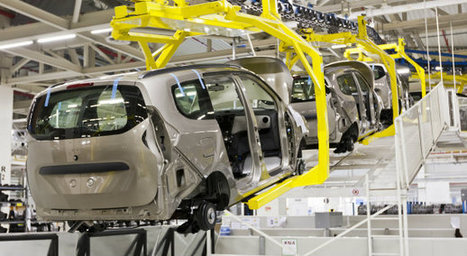Dans le cadre de la conférence ProGection du 8 octobre 2015 à l'IUT d'Annecy (France) Philip Marris explique les principes et bénéfices du Management de Projets par la Chaine Critique (CCPM), avant de démontrer pourquoi cette approche est très complémentaire du "Lean Engineering" ...
Get Started for FREE
Sign up with Facebook Sign up with X
I don't have a Facebook or a X account

 Your new post is loading... Your new post is loading...
 Your new post is loading... Your new post is loading...

Michel Baudin's curator insight,
September 14, 2013 12:29 AM
The gist of this article is that you should hold just enough WIP to meet your production requirements with the changeover times you currently have and protect your bottlenecks against malfunction in other resources.
So far, this is stating the obvious, and a visit to a Toyota plant or even dealership is enough to see that the Toyota system is not one with zero inventory. You see shelves of stampings, bins of bolts, and trees of wire harnesses. The Kanban system involves some inventory, and, in fact, the only approach that doesn't is just-in-sequence.
What is considered waste is not all inventory, but unnecessary inventory, accumulated for no valid reason anyone can explain. The article, however, goes further and asserts that it is cheaper to accumulate WIP than to expose and solve the problems that make it necessary, which is a return to the mass-production thinking that was prevalent in pre-Lean operations management.
What the Lean successes of the past decades have shown is (1) that the overall costs of WIP were understated and (2) that the ingenuity of production people and engineer was underestimated. You operate today and next week with the resources that you have, dysfunctional as they may be, and you hold WIP as needed to sustain production. As you do this, however, as an organization, you keep working at solving your problems so that you need less and less WIP month by month and quarter by quarter. This perspective is missing from the article. |

Michel Baudin's curator insight,
March 28, 2015 10:02 AM
Other than that Toyota has a plan, the article does not directly reveal specifics. As several readers pointed out in their comments, sharing components across models is not a new idea and is not risk-free, even if executed perfectly, as it reduces the differences between your standard and luxury models in ways that customers may notice.
The most revealing parts of the article, to me, are (1) the reference to VW, and (2) the keyword "modular assembly." Modular assembly sounds self-explanatory but it isn't. It is a specific approach to assembling cars brought to VW by former GM purchasing executive Jose Ignacio Lopez in the 1990s, in which up to 90% of the work traditionally done in a car assembly plant is done by suppliers and all that remains is the final assembly of large subsystems.
The Porsche plant in Leipzig, for example, does not stamp, weld, or paint car bodies. It receives them ready to assemble, in a spotlessly clean facility that customers are encouraged to visit.
The whole site is in fact dominated by its visitor center, complete with a fine-dining restaurant overlooking the plant and where new buyers can receive an hour's worth of training on their new cars on the test track. In the same spirit, VW has set up an assembly plant in downtown Dresden, with glass walls to enable passers by to watch cars being assembled.
Modular assembly was used by GM in Lordstown, OH, in 1999, (http://bit.ly/1NnPXwt) and then by VW in Spain, and by DaimlerBenz for the Smart in Hambach, France (http://bit.ly/1xmRyi6). At the time, Toyota evaluated the concept and passed on it. Apparently, Toyota's production leaders changed their minds. |










